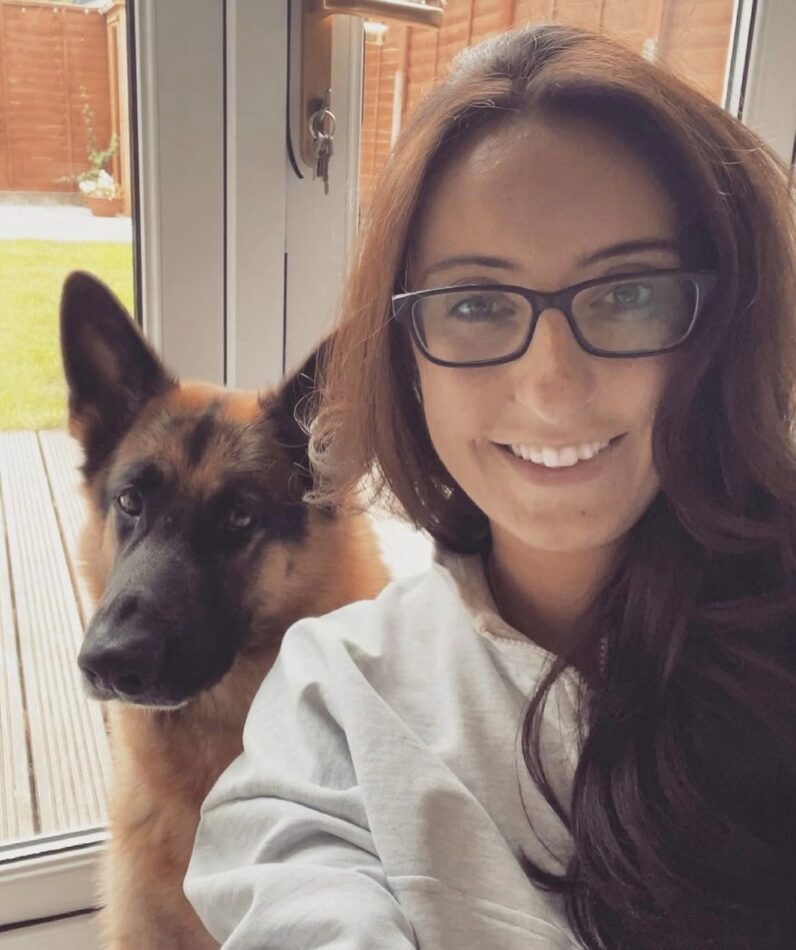
Canine behaviorist, Nikki Mather, explains our dogs’ adolescent phase and provides useful training advice on how to work through this stage successfully. Nikki, founder of Positive Steps Dog Training, is a qualified, force-free dog trainer (IMDT) and behaviorist (BCCS), predominantly working on cases including dog reactivity, separation anxiety and fear/anxiety-related behaviurs.
Most new puppy guardians prepare well for bringing home a new puppy, from toilet training to mouthing to sleeping through the night. And, just when you feel like you’ve mastered this stage of your puppy’s life, they turn into a teenager!
The teenage phase is a testing period of your puppy’s life, bringing new challenges and frustrations to you as a dog guardian. During this time, your dog may seem like they are purposely ‘ignoring’ your requests, they may become a little more anxious than before, or they may completely fly off the handle – but let’s take a look at what is really going on for our pups during this stage, as well as training tips to help you navigate this challenging time.
What is adolescence in dogs?
The transition from puppyhood into an adolescent “teenage” dog can happen anytime from around 6 months, lasting until your dog reaches anywhere between 18 – 24 months. During adolescence, dramatic hormonal changes take place within your dog’s body, resulting in a rewiring of their brain.
During your dog’s teenage months, you may notice an increase in their confidence, becoming increasingly motivated to explore and interact within the external environment. Alternatively, your once seemingly confident pup may begin to exhibit more anxious, fearful behavior. Regardless of the change, it’s important to remember that although older, your pup still lacks the experience and skill set to appropriately navigate our world and, therefore, is sometimes unable to rationally manage their emotions and reactions.
Behavioral changes you may notice
1. Increased anxiety (and therefore reactivity)
Most new puppy guardians are well aware of the importance of appropriately socialising your pup between 8-16 weeks. However, most aren’t aware that our dogs enter into a second fear period generally between 6-14 months.
During this stage, you may notice your once confident pup has become a little more anxious and fearful, which could result in an increase in reactive behavior towards external triggers they once may have been comfortable around, such as people and other dogs.
In order to work through your dog’s second fear period successfully, it is important to continue their socialisation training to ensure they are continually exposed to triggers at their pace. This will help continue to build positive associations that will create the foundations of a well-adjusted, confident adult dog.
2. Regression in training
We’ve all been there – we bring home a little puppy and immediately begin working on their loose lead skills and recall training. All goes seemingly well…our pups don’t want to leave our side so their lead work is perfect, their recall is second to none and they hang onto every word we say!
Then, the teenage stage hits, and it feels as though everything goes out of the window and our young dogs know nothing!
You’re not alone in this – ‘regression in training’ is completely normal. During the adolescent months, our dogs’ hormone levels change, and they can become much more confident in themselves and their environment. You may notice they listen to you less, they run over to distractions outdoors and they don’t come back when you ask – super frustrating! During this stage, our dogs are often conflicted when asked to do something, driven predominantly by their uncontrolled impulses.
When you begin to notice this regression, don’t panic! You just have to go back to basics in your training – in other words, you need to make it easier for your dog! This might mean you go back to working with a long training lead when teaching recall, or you may give your dog a little more distance from distractions to help them focus on you more. Take the time to work through your dog’s regression, training at a pace they can handle, and you’ll come out the other side with an adult dog that is an absolute dream to have!
3. Ignorance!
During your dog’s adolescent phase, you may become increasingly frustrated by how much they are choosing to ignore anything you ask of them – you may even call this stubbornness! Whilst this may seem like your dog is actively choosing to defy you, it is more effective to try and understand where this ‘ignorance’ has come from.
When they were pups, YOU may have been the most exciting, rewarding thing for them. Now that they’re a little older, their motivators and preferences will change, and you’ll need to up your game in order to keep their attention in a stimulating world.
To do this, you can try using high-value treats to reinforce behaviors you like, such as fresh meats, doggy pate or cheese (within moderation). You can also use chase toys, tug toys or balls to better engage your dog and reward behaviors you like. The more you reward a behavior, the more likely that behavior will be repeated!
4. Increased energy levels
As a pup, your dog will have needed around 16-18 hours of sleep per day. Now that they are a teenager, their sleep requirements will reduce, so they may become more active around the home for longer periods of time (more time to get up to mischief!)
Now more than ever, it is important to ensure you are meeting all of your dog’s needs, including physically, mentally, socially and breed-specific. Consider the quality of your dog’s walks, how often do they engage their brain in stimulating activities such as sniffing and problem-solving, do they have ample opportunities to engage in play with you and other dogs (when suitable), and are their breed-specific needs to chase/dig/search etc. being met?
If your dog is restless and exhibiting unwanted behaviors, there is probably an unmet need that needs to be addressed!
5. Nuisance behaviors
The adolescent developmental stage is when most young dogs begin to show troublesome behaviors, such as excessive barking, jumping, lunging, destruction or biting/nipping. Such behaviors are typically a result of your dog working through some pretty big emotions, frustration sometimes making top of the list.
If you notice your dog showing unwanted behavior, ask yourself WHY? There’s always a function behind our dog’s behavior – is there something they want, is there a need not being met, are they bored, tired, frustrated etc. Once you understand why the behavior is occurring, you’re better equipped to implement efficient training solutions!
Quick tips to help satisfy your adolescent dog:
- Let them sniff on their walks as this will tire them out mentally.
- Provide indoor mental stimulation such as enrichment boxes, snuffle mats and treats rolled into a towel!
- Balance high-energy activities with brain work-outs e.g. 5 minutes ball throwing followed by 10 minutes sniffing to help reduce adrenaline.
- Ensure you’re engaging with them through games, training or just cuddles – our dogs are social creatures!
- Teach them how to settle using a settle mat and ensure they have a quiet, undisturbed space to relax around the home.
Remember, your dog’s adolescent period will not last forever. Be patient and guide them into making more appropriate choices to help them co-exist peacefully with you. ‘Bad days’ are inevitable, but your hard work and consistency will pay off, and the relationship you’ll build with your dog along the way will be the most rewarding of all.
If you’re struggling and would like some professional help, please do get in touch with us at Positive Steps Dog Training.
This entry was posted in Dogs
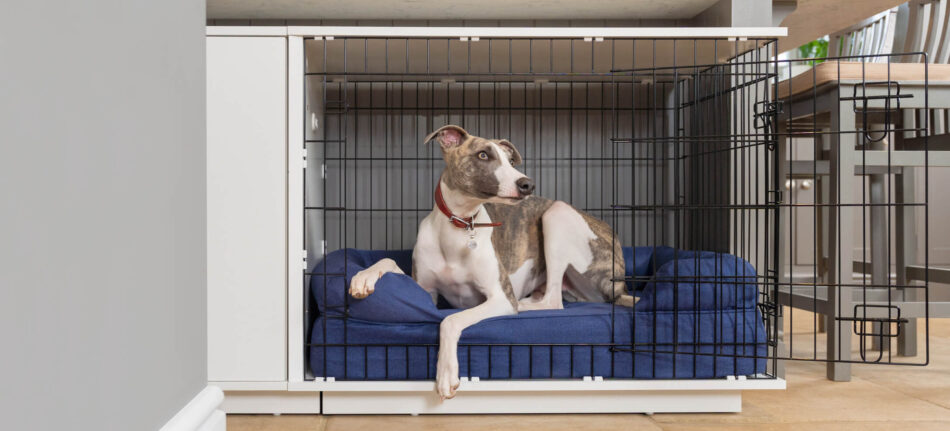
Considering crate training for your puppy or dog? While many people view dog crates as cages with cruel intentions, it’s actually been proven that dogs love a calm, safe place where they can rest and be by themselves. When introduced properly, crate training is an excellent way to give your dog a comfortable space of their own and help them learn new behaviors in the process. We’ve uncovered all the benefits and tips you need to know on when and how to use crate training as a tool and resource. Keep reading to learn more about crate training.
Why crate train?
Crate training is an important process in your dog’s life. Not only is it really helpful in potty training, but it’s also a great way to provide them with a secure space where they can retreat to in order to feel safe. So if you have a dog or new puppy in your life, take a look at all the ways crate training can be a useful tool in raising your new family member:
- Security: In the wild, dogs are naturally denning animals, which means they instinctively seek out small spaces to create a den-like feel. Offering your dog a crate to use at any age actually appeals to their innate behaviors and desires.
- Self-confidence: Think of how proud a toddler is when they learn how to use the ‘big potty’…the same is true for dogs! Through crate training, you set your pup up for success by helping them learn to reduce their wee and poop accidents.
- Self-reliance: As much as we wish we could spend every waking hour with our furry friends, the fact remains that sometimes we have to leave them at the house alone. When you crate train your dog, you give them a stronger sense of confidence to be ok by themselves when you have to be away from them for a while.
- Privacy: A dog crate can serve as a very useful time-out device for overtired puppies who need a break. It’s also a great place for your adult or senior dog to escape to when they want to be alone.
- Practicality: Being comfortable with a crate is important for dogs as they will be exposed to one eventually. Whether at the vet, the groomer or traveling in a car, crates are often used in other places to keep your dog safe and secure. So best to get them comfortable with a crate at home first.
Make crate training an enjoyable experience
A dog crate is meant to be a positive environment for your dog to see as an enjoyable place to be. The best way to ensure they have this association is to create that positive feeling from the moment of introduction to the crate. Here are some ways you can make crate training a truly enjoyable experience for everyone.
Choose the right crate
Finding the best dog crate is key to the success of your dog learning to love it. Depending on what dog breed you have, you want to make sure the crate fits your dog’s size and ability to turn around while in it. Other features your dog crate should have are durability, comfortability and transportability. The Fido Nook dog crate is a wonderful option as it provides all of these features while also doubling as a sleek piece of furniture in your home.
Create a positive association
One of the fastest ways to a dog’s heart is through their stomachs. So in order to encourage a positive association with the dog crate, use food and dog treats as tools. You can even move their dog bowls closer to the crate so they see the positive connection of eating and crate naps so close together!
Create a comfy spot
Some dogs prefer laying on hard surfaces and might be quite content just napping on the bottom crate tray. However, most dogs (and their owners!) prefer a more cozy spot to sneak away to. Try a comfortable plush dog bed that fits inside the crate so they can have more padding to snooze on. Or, just lay down a few cozy dog blankets so your dog can create the nap nest they desire.
Play crate games
It’s completely normal for dogs and puppies alike to be uncertain of a crate at first. How would you feel about seeing something so foreign and new for the first time? One of the best ways you can make crate training a less scary experience is by making it fun – and what is more fun than playtime? Get on the floor and use different dog toys to throw in and out of the crate to encourage a fun and playful game that makes your dog more comfortable with the new space.
Have patience
Any dog can learn new tricks and that goes for crate training, too. But only if you have patience and take it slowly. Like anything new, if you rush the process it is unlikely to stick, which can lead to frustration for you both. So take your time and allow your dog to warm up to the crate in their own time. Before you know it, they will be sneaking away to it all on their own!
Omlet and crate training
At Omlet, we believe having a dog is more than just owning a pet, it’s a relationship that is to be fostered. So we design our products to cultivate that connection so you two can spend more time together building those bonds. We believe crate training is an invaluable tool and while we didn’t invent the dog crate, we did perfect it. The Omlet Classic Dog Crate is engineered with durable welded steel and two door options for easy placement and openings. Use it by itself or place it inside the Fido Nook, for a more sleek and modern design that complements your interior. Whichever option you choose, Omlet can help make crate training your dog an easy and enjoyable experience.
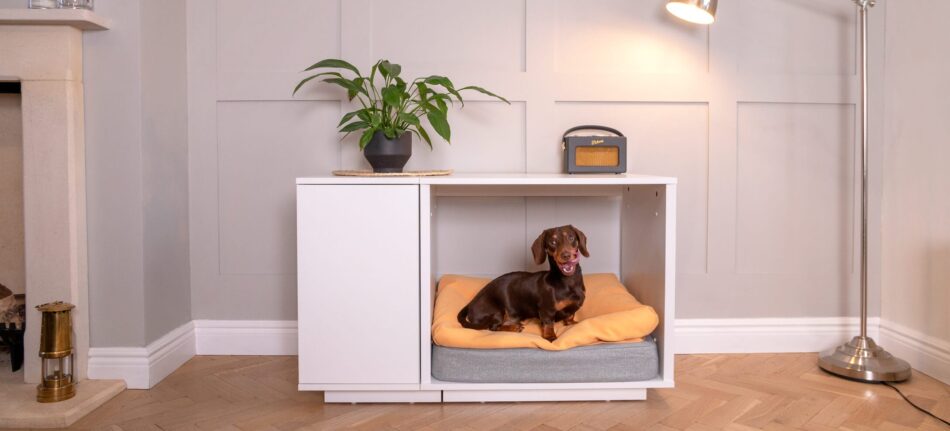
This entry was posted in Dogs
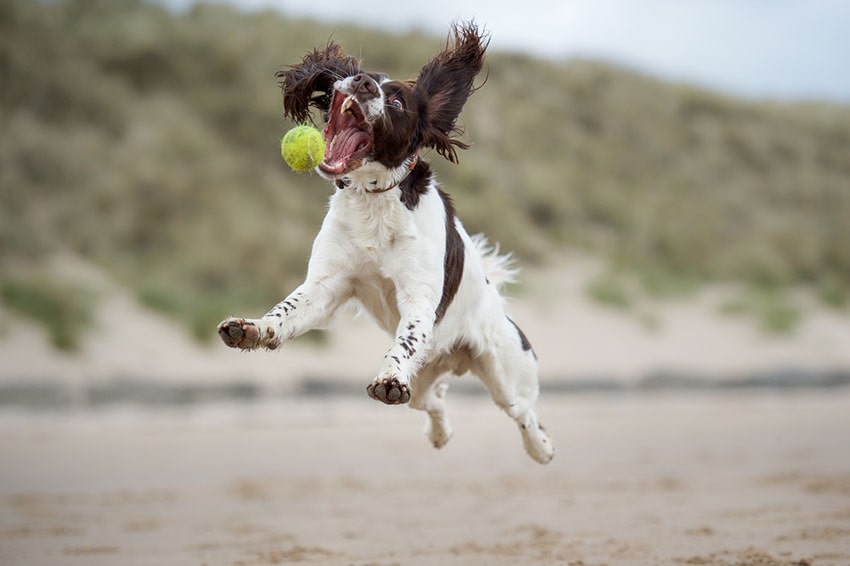
At some point, most dog owners will relate to not being able to find the motivation to get out of the house for a daily dog walk. But, when it comes to our four-legged companions, keeping on top of their exercise regime is essential for their physical and mental well-being. Rest assured though, walking your dog doesn’t have to be a chore thanks to these 11 tips on how you can make dog walks more exciting.
Encourage sniffing
Allowing for a few dog sniff breaks is a fantastic way to make your walk a lot more exciting for your furry friend. Did you know that scientists estimate that a dog’s sense of smell is anywhere between 10,000 to 100,000 times more accurate than ours?! So, while it might be slightly frustrating to feel as though you’re always stopping for your dog to explore, it’s crucial not to forget that this is how our dogs navigate the world. So next time you’re on a walk, give your pup some extra time to use their nose, and you’ll probably have a much calmer dog when you return home too.
Snap some Insta-worthy pics
Could your dog be the next big pet influencer? Why not have some fun and get your pup posing for a few pics while you’re out walking? Accessorize with a designer leash and matching collar from Omlet’s Dog Walk Collection, and you’re already halfway to getting the perfect pet pic.
Next, you’ll want to find a setting where you can get your dog’s attention to have them sit nicely whilst you snap away. You can find some tips on how to nail your pet photography in our How to take better pictures of your pet blog.
Take playtime outside
Dog games don’t have to be restricted to within the home. Most dogs love to play fetch, so this is always a good place to start. You can even substitute your dog’s regular ball with a treat toy for dogs you can hide some of their favorite snacks in. This will make their usual game of fetch more mentally stimulating and even maybe tire you out as well.
Alternatively, nose work games are also a great idea to incorporate into your dog’s walk, providing them with plenty of mental enrichment. Teach your pup the “find it” command and throw some treats into the grass to have them sniff out where you’ve placed them.
Practice training
Dogs need training throughout their lives and doing so outside whilst on walks is one way to make your regular stroll a bit more fun for the pair of you. Training outside means that there will inevitably be plenty of distractions, so keeping your pup stay engaged will require a lot of concentration. There are various ways to train your furry friend outside, from practicing loose leash walking, obedience training, or maybe even agility.
Enjoy a refreshing drink together
Walking is exercise and exercise can make both you and your dog thirsty. So why not route your walk to swing by a local restaurant or bar with a dog-friendly patio? Plenty of watering holes provide fresh bowls of water for four-legged friends while their patrons enjoy something from the tap. Both of you can enjoy a break from the trek and maybe even the company of other people, and dogs – a win-win situation!
A day out at the lake
While not the case for all, many dogs can swim. Weather permitting, take your dog out for a swim in a dog-friendly lake for a splash around during their walk. If your dog is not familiar with swimming though, it’s important to gently ease them in and never force them to do anything they’re not comfortable with.
After returning home, your pup will need a cozy and warm bed to relax on. The Topology dog bed is a fantastic choice, with a range of mattress toppers including a machine washable, absorbent dog bed Microfiber Topper that simply soaks up any mud and dampness from their swim. Taking your dog swimming on walks is even better in the summertime to help them cool down. Be sure to also take a cooling mat for dogs if you plan on heading out for a long walk to the lake when the weather does heat up.
Have a dog playdate
If your dog gets along well with other dogs, invite a friend to join you on your next walk to make it feel like less of a chore. Not only will you be able to have a nice catch-up with a friend, but your dog will also appreciate meeting up with theirs too.
Go to dog meetups
If you don’t already know anyone else with dogs, dog meetups are another opportunity for you and your four-legged friend to socialize with other people and dogs. Dog meetups are usually held in parks and involve meeting and then walking with other friendly dogs from around the local area. Alternatively, breed-specific dog meetups have soared in popularity in recent years, with a large number of dogs of the same breed all gathering in the same space for one big walkie.
Go somewhere new
Just like us, dogs enjoy a change of scenery. Doing the same thing, in the same place, every single day will eventually lead to you and your dog becoming very bored, so it’s a good idea to every so often change your route on walks. If your dog doesn’t mind getting in the car, you can even head out slightly further out on an adventure to give your dog a whole new experience, such as travelling to a beach. Should you be making a longer journey, Omlet’s range of secure crates like the Fido Classic will help to make for a much smoother ride.
Change the pace
Another way you can make the daily walk more exciting is to change the pace. Speeding up and slowing down at some points of the walk will get your dog’s mind ticking by keeping them engaged with you as they have to focus on what your next move will be.
Alternatively, for a particularly high-energy dog breed, why not change your walk to a jog? This way you’ll be able to get your workout in alongside taking the dog out! Before doing so, just make sure that your dog’s age and breed are suitable for running long distances.
Let Fido guide you
It’s often said that your dog should never be leading the way on walks. But, it can work out as a fun activity to occasionally see where your dog really wants to go. Simply take them out on their dog leash and hand directional control over to them! Although, if you’ve got a bigger dog who pulls on the leash a lot, this might not be the best idea…
Omlet and your dog
Omlet’s mission is to find solutions to pet parent ponders like how can a dog walk become a bit more exciting? And what’s the best way to travel with a dog? With products like the Topology dog bed, designer dog leashes and the Fido Classic dog crate, our designers continue to innovate products we know will inspire owners, bringing people closer to their pets.
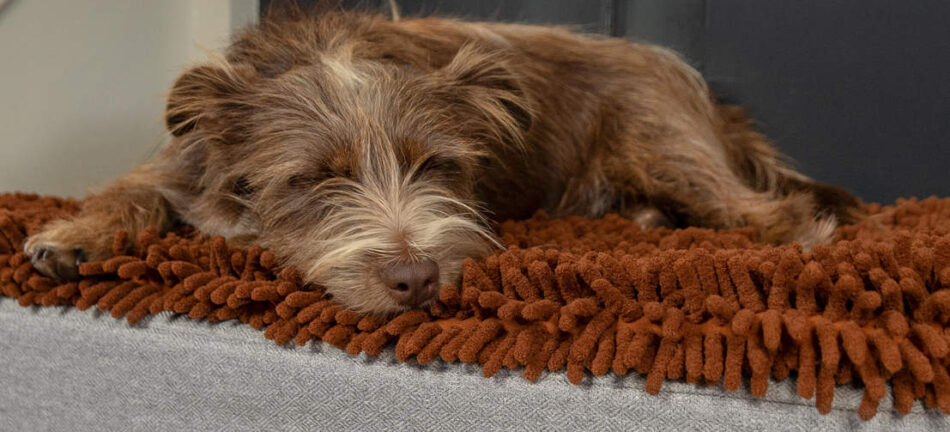
This entry was posted in Dogs
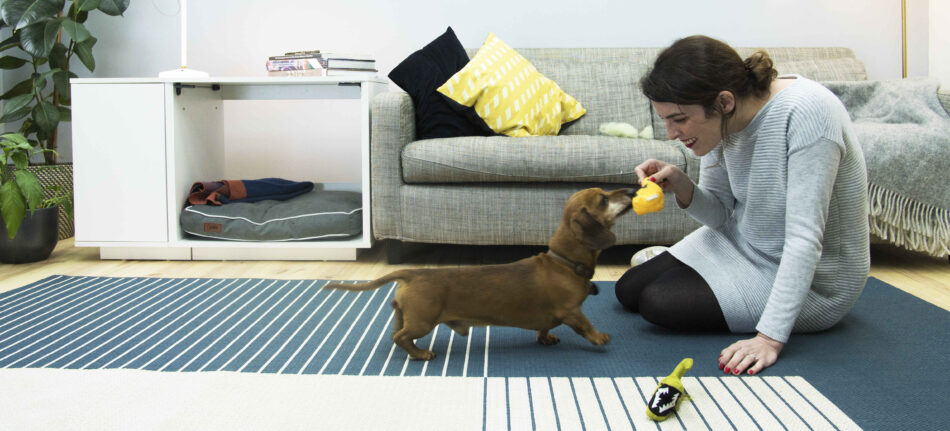
Come rain or shine our dogs need their daily walk… or two, right? But what happens when this just isn’t possible? Sometimes we can’t take our dogs outside for a number of reasons, be it extreme weather conditions, or maybe you’re in isolation. Regardless of your explanation, it’s a good idea to know how to keep on top of your dog’s physical health, as well as having an understanding of how to keep their brains engaged and stimulated while inside the home, even for when you’re able to take them for their regular walks again.
Although exercise with your dog inside most definitely does not substitute for your dog’s activity outdoors, there are a number of ideas to help you and your pup out, should you find yourselves in a situation when you can’t leave your home.
Physical Exercise Ideas
Tug of War
Tug of war is a great game to encourage your dog to exercise indoors. Before making a start it’s important that you’ve taught your dog the release command, to ensure they know how to drop their tug toy as soon as you ask them. Once they’ve mastered this, you can begin playing with a durable tug of war toy like the Triangle Tug toy on the Omlet site that comes in Blush Pink and Red, which you can use to tug back and forth with your pup.
Create an Obstacle Course
An obstacle course is a fantastic way to get your dog active around the house. You can make your course as simple or complicated as you want, and you’ll probably already have most of the equipment you need in your home! You can use a children’s play tunnel for your dog to run through, or even make your own using an old cardboard box, with treats to lure your pooch in. If you’ve got carpeted stairs, you can incorporate these into the course for your pet, or even use a hula-hoop or PVC pipes to have your pup jump through. You can really get creative here, as long as your dog is supervised at all times.
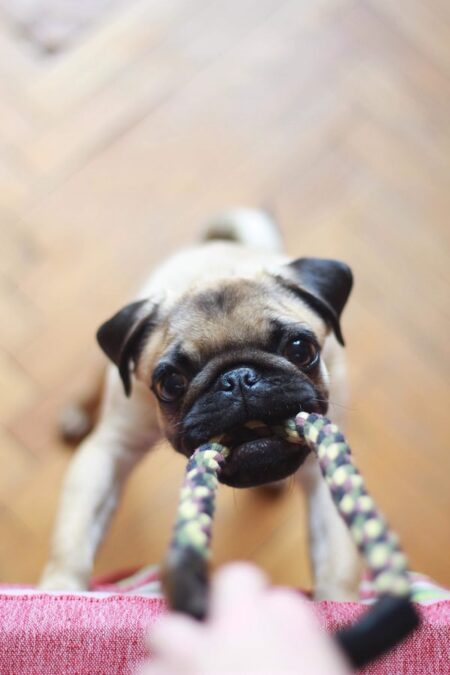 Play Fetch in The Living Room
Play Fetch in The Living Room
This is definitely one for a rainy day when it’s impossible to even play with your furry friend in the garden. This classic game is one form of indoor exercise that is bound to tire out your dog, but be wary of this one if you’re lacking the space inside (or a great aim!). Remember to always use a soft ball toy to play this game to avoid any damage.
Get a Treadmill
Treadmills aren’t just for humans! If you have a particularly active dog breed that you know is dependent on being outdoors for hours of running, a treadmill is a great way to get their physical activity in and tire them out. It’s not advisable to use a treadmill built for us to take your dogs on, so if you’re considering this option to exercise your dog, you can invest in a purpose built dog treadmill. That way you can be assured that your pup will stay safe, knowing the machine is suitable for their weight and joints.
Mental Exercise Ideas
Try Out Puzzle Toys
Exercising your dog isn’t all about physical activity. Physical and mental stimulation are both incredibly important, with mental stimulation being able to use as much energy as physical exercise for dogs. Invest in a puzzle toy or treat maze, a brain game that will really get your pup thinking, providing them with plenty of mental stimulation. Watch as your dog uses up their energy as they work out how they can get to their treats.
Play Hide and Seek
Although hide and seek can involve a lot of physical exercise, it also requires a lot of brain power from your dog. Find a hiding space and have your dog wait until you call their name to find you. When your pup finds your hiding place, give them lots of praise or reward them with a treat.
Teach Your Pup New Tricks
Teaching your dog new tricks is an activity you can do without hardly any space, and something that will keep them mentally engaged. You can begin teaching your puppy basic commands as soon as they arrive home, usually at eight weeks old. However, as your pup gets older these can become more complex and fun.
You can try hiding some of your dog’s favorite treats to really get their nose (and brain) working. This game is perfect for mental enrichment for your pup, and also one you can try to incorporate into your obstacle course. Before hiding your pup’s treats, teach them the “find it” command, so they know what to do when you release them to go on their scent hunt. You can first hide a treat under a towel and then build this up to hiding treats around the house.
Being stuck indoors is no fun for you or your dog, but hopefully after a bit of inspiration you’ve been able to pick up helpful tips to make it a lot less boring before you can be out and about again.
This entry was posted in Dogs
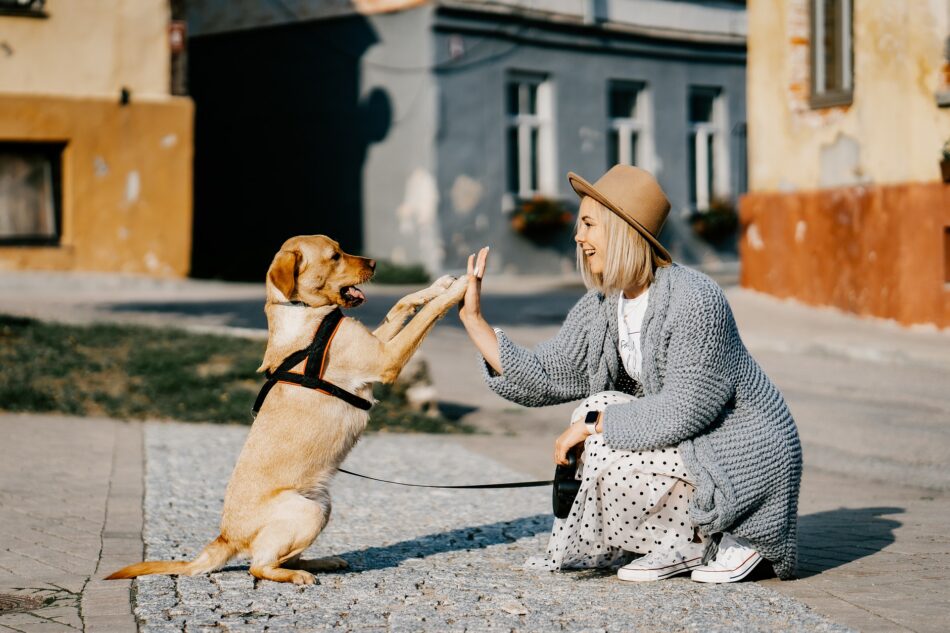 A dog who has been taught positive behavior will be your best friend – fun, affectionate and reliable. It’s straightforward teaching your dog this canine version of positive thinking, but it won’t happen unless you lead the way.
A dog who has been taught positive behavior will be your best friend – fun, affectionate and reliable. It’s straightforward teaching your dog this canine version of positive thinking, but it won’t happen unless you lead the way.
There are many ways of teaching a dog the rights and wrongs of living in the human world, and that extends to how they interact with other dogs and the world around them. In this article, we reveal the five rules of thumb for all dog owners – whether you’re training an adult dog or a puppy.
Encouraging Positive Behavior in Puppies
Puppies recognize when we’re pleased or displeased. It’s all part of their instincts, and in the wild this instinct helped their wolf ancestors find their place in the pack very quickly. Learning their place in the big wide world is all about positive reinforcement.
1. Puppy Treats. Dogs of all ages love food and will put lots of effort into doing what you want them to do as long a there’s a yummy treat at the end of it! This means treat-based training can be used for everything from toilet training to basic obedience training and that all-important early socialization. The message here is simple and timeless – do this right, and you’ll get a treat!
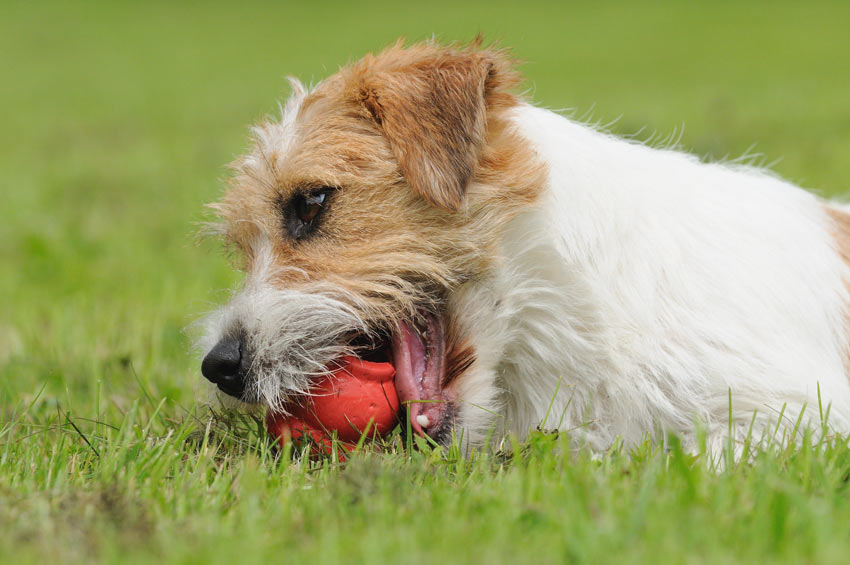 2. Affection. This is arguably even better than a food treat! Bonding with a puppy involves physical contact in the form of belly-rubs, back stroking and lots of gentle words of affection and encouragement.
2. Affection. This is arguably even better than a food treat! Bonding with a puppy involves physical contact in the form of belly-rubs, back stroking and lots of gentle words of affection and encouragement.
3. Fun and games. Tug-of-war, fetch and simply running around the backyard with you are games that puppies love. What’s more, they strengthen the bond and love between you and your pet, and that’s the perfect groundwork for training and encouraging positive behavior.
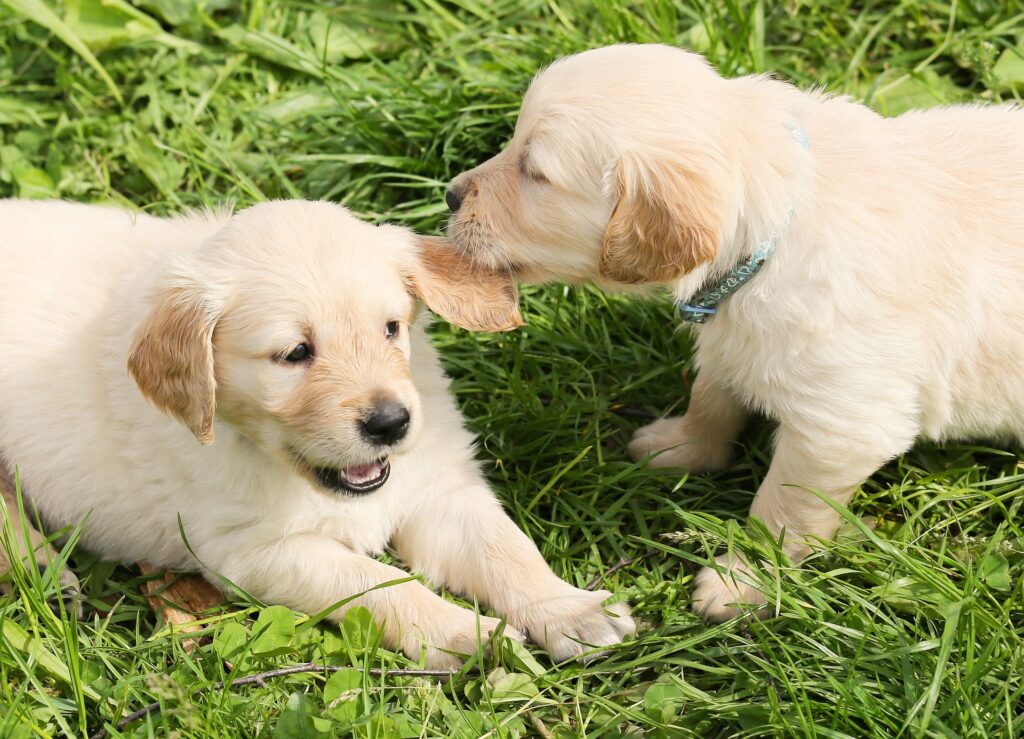 4. A trip to a favorite place. This is a great treat for dogs, and can be as simple as a trip to the park, or perhaps to a favorite street for an on-leash walk, or maybe a shop that sells some of those yummy treats! If this is being done as a reward for good behavior, make sure your puppy knows it by telling them what a good boy/girl they are as you put the lead on or get into the car!
4. A trip to a favorite place. This is a great treat for dogs, and can be as simple as a trip to the park, or perhaps to a favorite street for an on-leash walk, or maybe a shop that sells some of those yummy treats! If this is being done as a reward for good behavior, make sure your puppy knows it by telling them what a good boy/girl they are as you put the lead on or get into the car!
5. Puppy playdates. Starting these early is a great way to socialize your puppy, and that provides the basis for all the positive behavior training. Young dogs love meeting each other – it’s not going to be a quiet morning out with your furry friend, but it’s one that will give him or her essential social skills.
Encouraging Positive Behavior in Adult Dogs
The basics are simple. Positive reinforcement rewards a dog for good behavior and ignores, rather than punishes, undesirable behavior. Punishment will only lead to confusion and fear in your dog, reducing your chances of achieving the full benefits of positive-behavior training.
Here are the five ways to make everything go smoothly, no matter which dog breed you have.
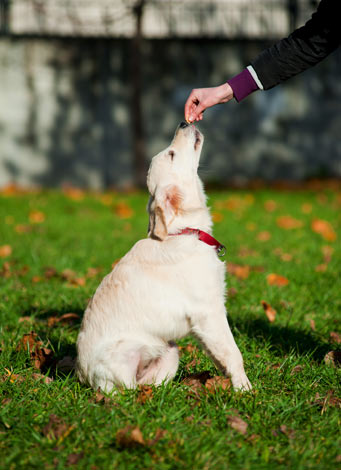 1. Keep it simple. One-word commands are better than complex ones. We’re talking here about sit, come, etc. Save the long-winded exchanges for praise and affection! A training session based on simple commands and treats is a great start for encouraging positive behavior. Which brings us to…
1. Keep it simple. One-word commands are better than complex ones. We’re talking here about sit, come, etc. Save the long-winded exchanges for praise and affection! A training session based on simple commands and treats is a great start for encouraging positive behavior. Which brings us to…
2. Treats. Just like puppies, adult dogs will be well and truly ‘reinforced’ if treats are involved. Some breeds are more food-obsessed than others, but all types of dog will quickly learn that good behavior results – at least in the early days of training – in a yummy treat.
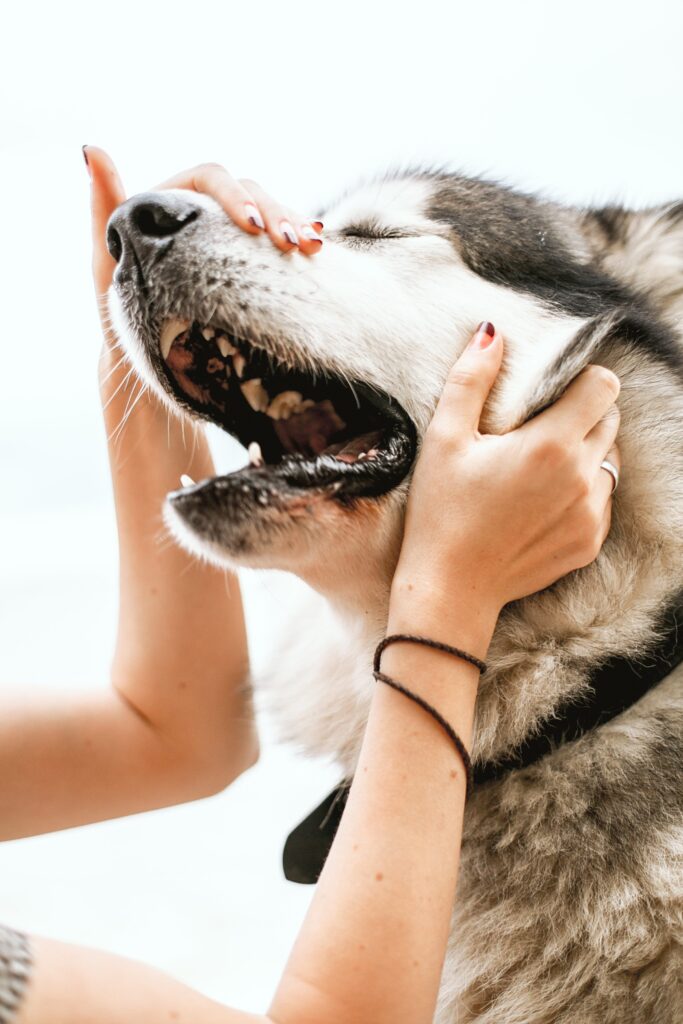 3. Quality time. Dogs are social animals by instinct, and they will thrive in human company. Once you and your pet are the best of friends, the positive behavior training will be much easier. If there’s any nervousness or standoffishness in your dog, they will be less able to take on board the things you’re trying to teach them. So, keep up the contact, and play with them every day.
3. Quality time. Dogs are social animals by instinct, and they will thrive in human company. Once you and your pet are the best of friends, the positive behavior training will be much easier. If there’s any nervousness or standoffishness in your dog, they will be less able to take on board the things you’re trying to teach them. So, keep up the contact, and play with them every day.
4. Make it fun. A long session of ‘sit, lie down, stay, come’, etc. will soon become boring for a dog. A short session of command-based training followed by a bit of fun, however, will make your dog look forward to the sessions every time. After five or ten minutes (depending on your dog’s stamina), round off the proceedings with a game or a walk. The dog will soon realize that “If I do this tricky part, I get that fun reward afterwards!” It’s a trick that works just as well with young children – “Finish your homework, and then we’ll go out on a bike ride!”, that kind of thing.
5. Get everyone involved. Once your dog has grasped some of the basics, other members of the family, or friends, can reinforce the good behavior by running through some of the training with your dog. Your pet will then learn that positive behavior is part of their general lives and applies in all situations with all people.
This latter point is the ‘quantum leap’ for a dog – the idea that positive behavior extends beyond their immediate owner to the big wide world around them. Getting them to this point takes time, there’s no doubt about that, and some breeds are a lot easier to train than others. However, once the work has paid off, you’ll have a doggy best friend you can be truly proud of!
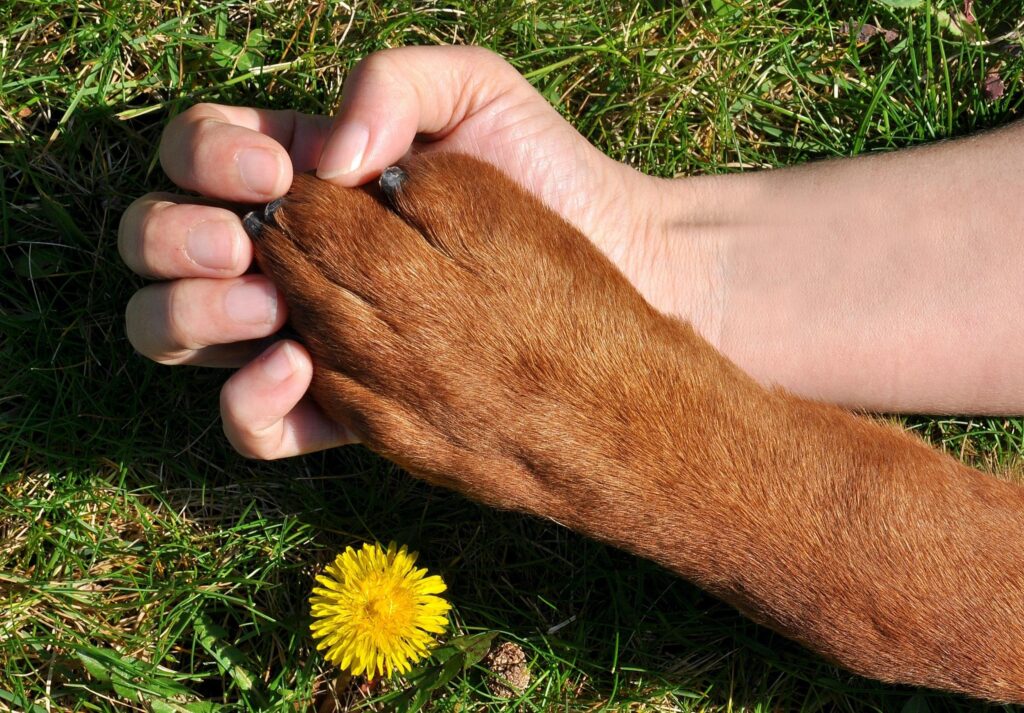
This entry was posted in Dogs
Dogtor Adem, founder and owner of Dog-Ease, is a dog behaviorist and trainer with over 15 years experience working with dog owners and their canine best friends. In this blog post, Adem provides us with helpful tips on preventing dog theft, and what to do if you experience dog theft yourself.
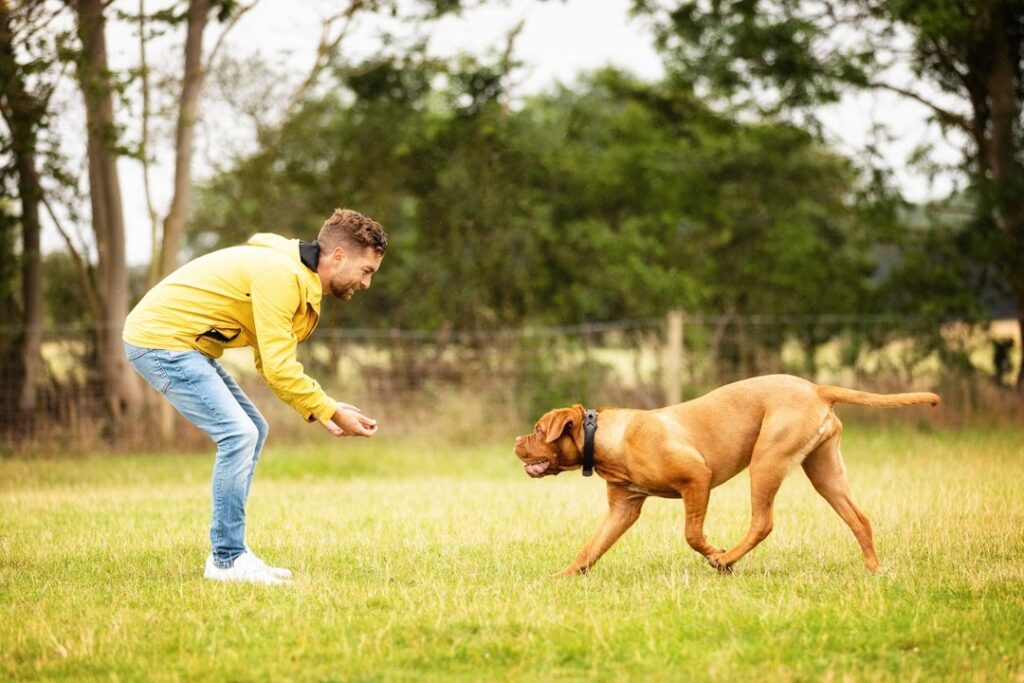
With dog theft on the rise, it’s only natural that we might feel worried about taking our furry family members out and about at the moment. I think most of us can agree that if anything should happen to them, we would feel devastated. So, I have put together my top tips for keeping your dog safe from theft when both at home and out and about. Following on from this, I’ve also put together some tips on what to do should you find yourself in the awful position of your dog having been stolen. I hope you never have to refer to them, but they might just help you be reunited should you find yourself in this unfortunate position.
MY TOP TIPS FOR PREVENTING YOUR DOG THEFT
START AT HOME
By this I mean you should review your current security measures at home. Start by ensuring gates and fences are secure and avoid leaving your dog in the backyard unattended. You may also want to ensure your dog cannot be seen by people passing by when you are out of the home. You can do this by making them a base in a room away from any windows that can be easily looked into or even by closing the curtains on these windows when you are out.
MAKE SURE YOUR DOG IS MICROCHIPPED
It is not only law to have your dog microchipped, but it is also best practice. If your dog is ever separated from you a simple scan of their chip in their neck area should reunite you pretty quickly. Keep your dog’s microchip details up to date. It’s usually really easy to do this over the phone or online.
ADD AN ID TAG TO YOUR DOG’S COLLAR AND CONSIDER A GPS TAG ALSO
By law, your dog should have an identification tag attached to their collar when outside of your home. This makes it really easy for you both to be reunited without needing your dog’s microchip to be scanned. You could also consider attaching a trackable GPS tag to your dog’s collar. There are many on the market to choose from and these can be purchased online, if not from your local pet shop. Some also have fun features to use on a daily basis such as tracking your dog’s activity levels.
TEACH YOUR DOG THE RECALL COMMAND
Teach your dog the recall command and make coming back to you a fun game that you can play throughout your walks together. Offer a tasty treat or engagement in a game such as fetch each time they return to you. This makes them more likely to want to return to you, seeing the recall as a fun part of your walk. Head over to the Blog page of my website www.dog-ease.co.uk/blog/ to watch a tutorial on how to begin this training if you haven’t already had a chance to.
KEEP YOUR DOG’S ATTENTION
Make it fun for your dog to stay close to you on your walk if you are letting them off leash. For example, you could practice off leash heel work as you walk, offering a tasty treat as a reward for their focus, or play recall games. Taking a special toy such as a ball can also help to keep your dog’s attention and focus with them chasing and retrieving during your walk.
KEEP YOUR DOG IN SIGHT
Following on from keeping your dog’s attention, avoid letting your dog go out of your sight on a walk or leaving them unattended outside a shop, school, or even in your car. The less opportunity for them to come into contact with strangers without you also present, the better.
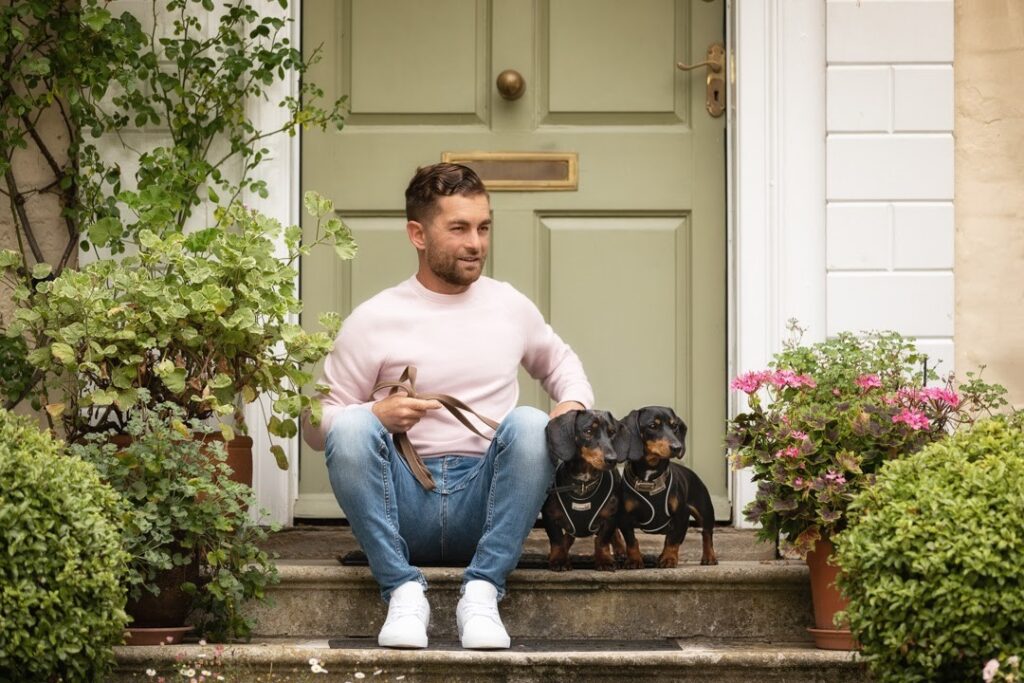
WALK WITH OTHERS
If possible, walk with a family member or socially distanced with a friend. You could also try to walk in public areas where other people are walking and present too. Pick times of the day where other people are likely to be around and walk in daylight if possible. If this is not possible, try to walk in well-lit areas. Safety is often found in numbers and the more people that are around the less likely you may be to be targeted.
CONSIDER TAKING ANTI THEFT DEVICES WITH YOU
Consider taking an anti-theft alarm or another similar device on your walk with you, even a whistle is better than nothing to be able to attract attention with. You could also try to keep your mobile phone handy to use if necessary, although it’s best to not allow your cell phone to distract you from what is going on around you as you walk. See the next tip!
STAY ALERT
Following on from the tip above, stay alert and be vigilant on your walks. Watch out for any unusual activity or people in the areas you might typically walk. It is best to limit your use of any electronic devices such as your cell phone, even to listen to music. The more aware of your surroundings you are, the more likely you will be to spot anything not quite right.
AVOID CLOSE CONTACT WITH STRANGERS
Avoid letting people you don’t know pet your dog or telling people you don’t know any details about you and your dog. It’s nice to be friendly but be vigilant about the information you share.
BE LESS PREDICTABLE
If you’re particularly concerned, change up your routine frequently. This makes it harder for anyone ‘watching and waiting’ to predict and plan to ‘bump into you’ on a walk.
PREP OTHERS WHO ARE RESPONSIBLE FOR WALKING YOUR DOG
If you use a dog walker, ensure you ask them what steps they are taking to avoid your dog from being stolen. You can also ask that they remain vigilant in securing your property when returning your dog to your home and ask that they look out for and alert you to any unusual activity.
USE SOCIAL MEDIA AND LOCAL NEWS TO YOUR ADVANTAGE
Check local social media pages and local news for up-to-date information on what is going on in your area. Often any worrying incidents are reported by residents with details of suspicious people and even sometimes vehicles too look out for.
BE MINDFUL OF WHAT YOU SHARE ONLINE
Sharing your location and details of your pet on non-private forums such as on non-private social media pages can alert potential thieves about your destination. Make sure you are mindful of what you share and where you ‘check in’, with or without your dog.
WHAT SHOULD YOU DO IF YOUR DOG IS STOLEN?
In the awful event that your dog is stolen, here are some tips to help you find and be reunited with them.
REPORT THE THEFT IMMEDIATELY
Report the theft immediately to the police and ensure it is recorded as a crime rather than as a lost pet. You should receive a crime reference number for your records.
CHECK CCTV
Check all available CCTV footage in the area your dog was stolen from to gain evidence of any people needing to be identified or vehicles that may have been involved. You might also want to check in with neighbors and those in the local area to see if anyone has any footage from their own security systems – from Ring Doorbell footage to Dash Cam footage. Anything is worth a shot and could lead to identifying something or someone.
CONTACT YOUR MICROCHIP COMPANY
Contact the company your dog’s microchip is recorded with and register your dog as stolen. If your dog is scanned by a vet elsewhere, they should then be alerted to this and your dog returned to you.
CONTACT LOCAL VETS
Contact all vets in the local area to let them know of the theft. Provide a photo of your dog if possible and include details of any markings or particular features that they have so they can identify them more easily.
MAKE THE PUBLIC AWARE
Make other people aware of the theft by putting up posters stating your dog has been stolen, with your contact details on them. You should also post a copy of such posters, or an equivalent, on social media sites. If you ensure that the settings of your post are set to ‘public’ you can ask others to share your post and reach a much wider community. The further your dog’s details are shared, the more chance you have of your dog being identified and returned to you!
DON’T GIVE UP
Don’t give up hope! Keep sharing your dog’s details far and wide. Someone somewhere might know something and help you to be reunited.
I hope you found the above tips useful. Stay alert and keep safe!
Dogtor(tm) Adem
Owner of Dog-ease Training & Behaviour
www.dog-ease.co.uk
This entry was posted in Dogs
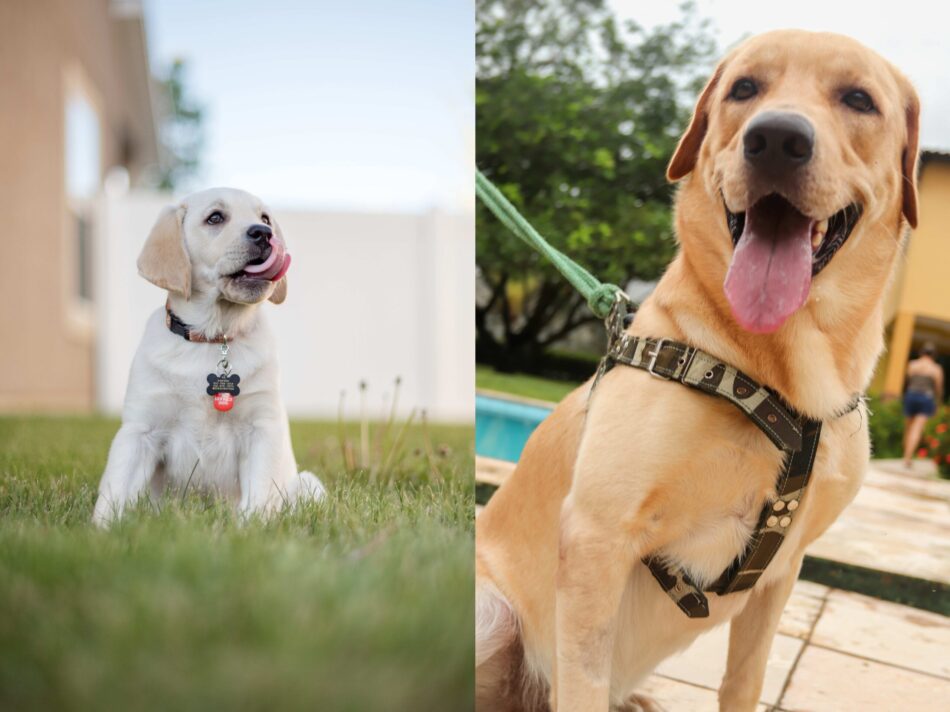
It can be tricky to decide whether or not your dog should wear a collar or a harness for walks. A lot of it depends on your dog himself, from the breed to his age and activity level. No matter what type of breed you have, one thing’s for sure, they all need to go out on walks! The main two types of leash attachments that you can use for your dog are harnesses or collars.
Whether you just got a new dog and aren’t sure which to use or you are looking to switch things up, it’s important to know the pros and cons for both dog harnesses and collars before making a decision.
Collars
Pros
Dog collars are the best when it comes to controlling aggressive dogs, puppies or dogs who are in training. It gives confidence to the owners where they can let their dog walk without any fear. It comes with many direct benefits while providing better control to the handler. Dog training is one of the most important reasons for buying a dog training collar. It is one of the first dog training tools that an owner would need. It helps your dog to successfully overcome obstacles. It also helps to guide your dog and secure his attention if it has a short attention span.
Your dog may get a bit rowdy during the walking session. It’s the dog collar that can correct its behavior when it is misbehaving. Dogs can go on jumping fences, playing in woods, or getting into mischief; so, you should consider durable dog collars with breakaway fasteners.
A dog collar is more convenient than a harness: The main benefit of collars
is that they can be left on at all times as opposed to a harness, which should only be worn during walks and it’s much easier to snap a collar on and off than a harness.
Another great benefit of wearing collars comes with the metal ring where you can attach your pet’s ID tag
or name plates with your address, your phone number, veterinarian office phone number or the tag of the dog registration organization where your dog is registered for identification in case, he or she gets lost.
Are you a fashionista or do you love to express individuality? You can even use a bow tie or bandana/scarf as an attachment for the collar.
Cons
What can go wrong when you lead a dog by the neck? Quite a lot, it turns out.
The safety of your dog’s neck plays a vital role here. If dogs constantly pull against their collar, they can injure themselves or reduce the airflow they are getting. Some smaller breeds, like miniature dachshund or poodle, are prone to collapsing tracheas, and a rough tug on the collar can quickly turn into an emergency situation.
Other dogs’ necks are as thick as their heads, e.g., pugs and whippets, so slipping out of a collar is effortless. Even if you have a tough mutt or working dog, repeated pulling on the neck can lead to thyroid damage or spinal injuries over time. Please avoid using collars to walk dogs with medical issues such as glaucoma, neck injuries, or spinal malformations.
Collars should also not be used on toy breeds and brachycephalic breeds, such as Chihuahuas, Chinese Crested, Italian Greyhound, Maltese, Toy Poodle, Yorkshire Terrier, Bulldogs, French Bulldogs, Boston Terriers, Pugs and Boxers.
Harnesses
Pros
The main benefit for using a dog harness instead of a dog collar is the control you have over overly excited dogs, as you have more control over them. If it comes to safety and security harnesses are generally better at preventing accidents because they fasten more securely around your dog’s body and are simply the most secure, and most comfortable way to hook your dog up to his leash. It covers your dog’s chest, shoulders, and upper back, which disperses pressure over a larger surface area whereas collars give you better control over your dog. While dogs can easily slip out of their collars and potentially run into traffic or another person’s yard, harnesses offer much more security and safety.
A good harness will reduce pulling, increase your control over your pup, and decrease stress on his neck and joints. Bonus points: because it secures closer to the dog’s center of gravity, a harness gets tangled in the leash less and helps prevent jumping.
Also here, for the individualists among us, there are different kinds of harnesses, starting from cool, cute or practical, such as bags where you can put some treats or eco-friendly waste bags.
When it comes to specific breeds or diseases, a harness has a better function for your dog:
- Brachycephalic breed: These breed dogs typically have flatter faces, “shortened head” and refers to the short nose and flat face of dogs like Pugs, Shih Tzus, Chihuahuas, Chow Chows, Pekingese, French Bulldogs or Bulldogs. Respiratory issues may be better managed with a harness.
- Tracheal collapse: This is a medical condition where the trachea will fold in on itself causing trouble breathing and a cough. Please avoid using a collar because it applies further pressure and can even worsen the condition.
- Risk factors for spinal problems: A condition called intervertebral disc disease (IVDD) makes long-bodied breeds such as dachshunds very prone to slipped disks. By using a harness, you can take pressure off the neck and back and help prevent further damage.
- Orthopedic disease: Dogs with orthopedic disease can have a hard time getting up to walk so a harness can help you get them up and move around more easily.
Cons
Harnesses are just less convenient than collars for humans. A collar can just slip on, but harnesses take more time to fasten.
Harnesses can be uncomfortable: Harnesses are bulkier than collars, so they can be more uncomfortable for your dog. Some dogs really don’t like wearing harnesses, so it can take some time for them to get used to it.
Harnesses may not have a place for carrying an ID tag. It’s best to get a harness with a ring for a tag-or use both a collar with a tag and a harness when out walking.
If your dog wears weather protection or due to some illness needs to wear clothes, a harness might be a bit more of a disadvantage than a collar. The clothes might cover the harness ring(s), so that you’re unable to put a leash on. Alternatively, you can attach the harness over the clothes but make sure -in general- it’s neither too tight nor too loose.
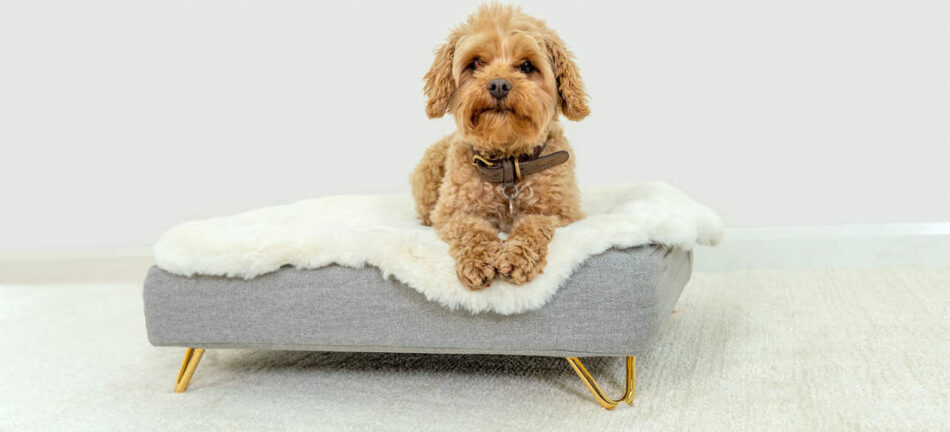
The Sheepskin Topology Topper provides dogs with a luxurious place to rest
Summarizing
So, collar or harness – which one is now the better option for your dog? There is no general answer to this question as it always depends on the breed and health of your pooch and the use of the item. However please, always keep in mind:
- Collars are less restrictive on movement, which is good for working dogs who are running around all day. Collars are also better for dogs that don’t pull and can calmly walk by your side.
- Harnesses are better for overly excited dogs as you have more control over them.
- Smaller dogs and brachycephalic breeds should avoid wearing a collar.
- It is absolutely advisable to get your puppy used to both, collar and harness.
- If you want to transition an older dog or even a pup from collar to harness, be patient – the adjustment phase may take some time. Bring some treats along on your first few harness walks to distract your dog from that unfamiliar feeling, as well as associate the change with positive rewards.
- It also depends on the use of the item. If you want to have a walk with your buddy or take a ride with him in your car (to fasten the seatbelt), it is recommendable to use a harness. If you just let him out in the backyard or take him to your friends’ house, a collar is totally fine – same goes with dog kennels.
To sum up, harnesses are usually the best choice for walking dogs because they don’t put pressure on the neck. But collars are generally more comfortable and have a place to hold an ID tag. At best, let your buddy wear both: If you can’t attach a tag or name plate to the harness, use a collar for the ID tag and a harness for the leash.
This entry was posted in Dogs
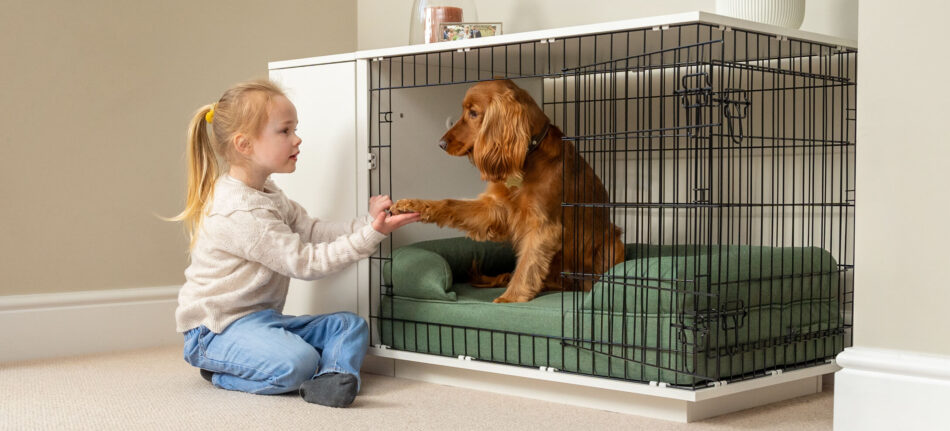
It’s a fantastic achievement to transform that over-excited, jumping, weak-bladdered puppy into a trained and trusted friend and companion. The transformation isn’t automatic, but comes about through persistence, organisation, and a few simple dog training tools.
You can find several training tips on our Omlet Dog Guide. Here, we’ll highlight a few things that can slow down the training process.
1 – The training sessions are too long
This is definitely rule number one. Training takes a lot of canine concentration, and if you overdo it, your dog will become bored and/or impatient. And frankly, so will you. A training session should be between five and ten minutes. After that, it’s time out. You can resume the training with another 10-minute session an hour or so later.
2 – You’re getting impatient
You might think your dog is the cleverest pet you’ve ever met. But he’s still a dog, and not a human, so you shouldn’t expect miracles. A dog has to concentrate to learn new commands, especially ones that go against his natural instincts to run, bark, eat, and jump up to greet people. Many owners lose patience when, for the umpteenth time, the dog fails to respond to a command, lies down instead of sitting, forgets to wait when you tell them, and so on.
As soon as you lose your temper, your dog will sense the hostility and begin associating training with human anger. Understandably, he’ll not be too keen on taking part in future sessions.
3 – You’re on auto-repeat
If your dog fails to get the hang of a new command or trick on the third attempt, let it go. The mystified mutt will have made three incorrect guesses, and getting it right after ten attempts will not make the training stick. Revisit these ‘fails’ in later training sessions. Review your approach – was it too vague, too similar to another command, or have you fallen into the traps mentioned in points 1 and 2 above?
Similarly, if your dog fails to lie down when you say “lie down”, don’t repeat the command endlessly. It will tell the dog he doesn’t need to respond immediately, or it might make them think that the command for ‘lie down’ is actually “Lie down! Lie down! Lie down! Lie down! Lie down!…etc.”
4 – Everyone’s moody
If a dog is tired, grumpy, hungry, or expecting his regular walk, a training session isn’t going to go down well. The same applies to the human trainer – if you’re not in the best of moods, the dog will know, and neither of you will be in the best frame of mind for a training session.
5 – The default approach is punishment
There are two ways of training a dog – the old-fashioned correction-based method, and the much better ‘positive reinforcement’ method. The old way involved punishing a dog for getting things wrong, while the modern way is to reward them when he gets it right. Some owners mix and match the two methods, which can be confusing. The poor dog doesn’t know what’s coming next – a tasty treat or an angry gesture.
You should never shout your dog’s name in anger or as part of verbal punishment either, or he will come to associate his name with negative things.
6 – The training is inconsistent
Always use the same command words for each action, and make sure the dog performs the required action once he’s learned it. If you give the command and then let it slide if the dog doesn’t bother responding, you’re undermining the process. When training a dog you’re establishing sets of rules, and consistency is the only thing that’s going to make them stick.
If using a dog clicker, make sure the clock is reinforced with a treat. And don’t click loads of times for a single training action or behavior, or the click will lose its meaning for the dog.
7 – The training is tailing off
If a dog learns new tricks and performs well in early training sessions, it doesn’t mean the behaviors will stick in his head forever. They need reinforcing every day over the dog’s early months, otherwise he will get rusty (a bit like you trying to recall those school French lessons 20 years later). Some owners make the mistake of thinking a paid-for training session can replace a year of regular and patient training. It can’t.
8 – Bad behavior is being rewarded
If a dog is misbehaving, it can be tempting to shout their name angrily, and then reward them with a treat or attention when they decide to come. To a dog this means bad behavior = reward. Ignore the bad behavior as much as you can and draw a line by distracting the dog by asking them to sit or lie down (without using his name). You can then reward the good behavior.
9 – You’re overdoing the treats
If dog treats are given too frequently or the portions are too large, your dog may decide, later, that he will only listen if there is food involved. There are also health issues involved with overdoing the snacks too. Praise, play and affection are just as important as food treats when training.
10 – A bull terrier can’t be a sheepdog!
There’s no single ‘best way’ to train a dog. It depends on breed and temperament. So, don’t rely on previous experience or the advice of another dog owner, if the dogs in question were completely different characters.
No dog is born pre-trained. But by avoiding these 10 common mistakes you’ll make the training much more effective, ensuring that everyone involved – human and dog – has a great time during the process.
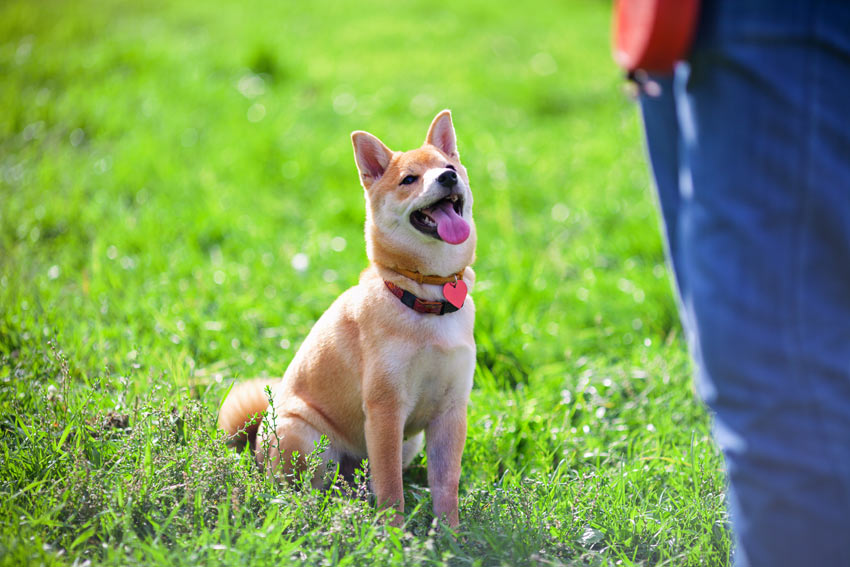
This entry was posted in Dogs
Richard Whately, 19th century Oxford academic and Bishop of Durham, taught his dogs to climb trees on the banks of the river Cherwell, and jump into the water from the branches.
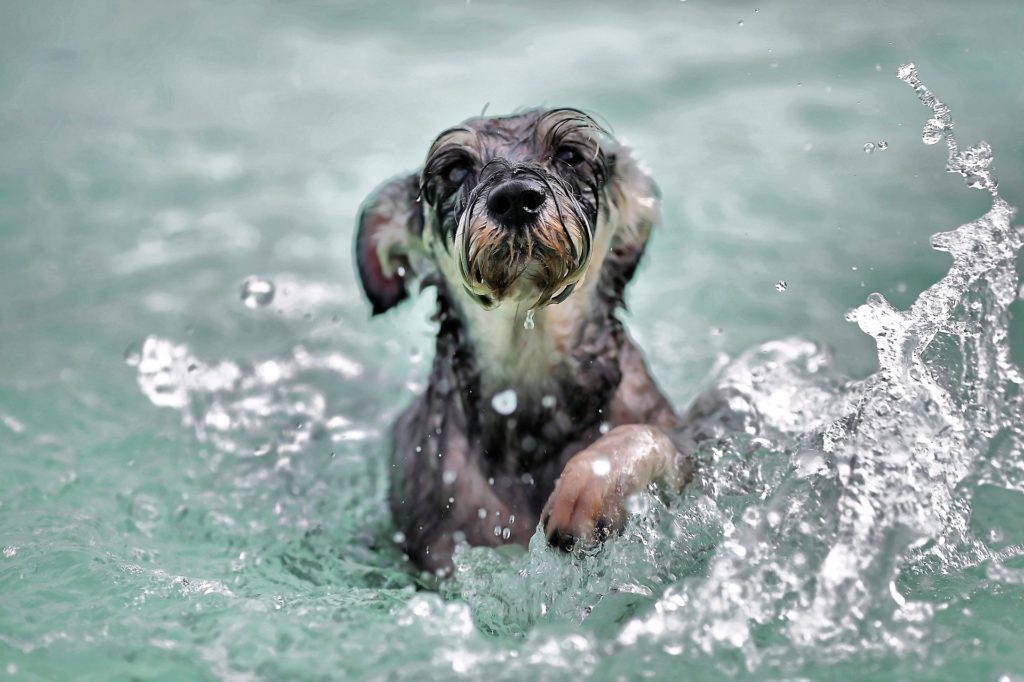
Fortunately, there are much easier ways of getting your pet dog used to taking a dip. But the key word in the previous paragraph is ‘taught’. Dogs are not born swimmers – they need teaching to a certain extent, even though most of them can stay afloat and doggy-paddle their way back to shore if you throw them in. But this is certainly not a recommended way to introduce pooch to the pond!
Many of them need no persuasion at all, and jump into rivers, ponds and the sea at every opportunity. Others are less eager to take the plunge, and some breeds are simply not built for the doggy paddle.
Sorting the Water-Dogs from the Non-Swimmers
Dog breeds with no snout, such as the Boxer, English bulldog, French bulldog, Pekingese and Pug, have great difficulties keeping their noses above the water. Their squashed muzzles – ‘brachycephalic’ is the proper term – means they are simply not built for swimming. Similarly, breeds with large heads and muscular upper bodies such as American bulldogs and Staffordshire bull terriers are not able to swim well, or at all.
Dogs with short legs find it hard to get very far in the water, even though they are capable of holding their heads above the surface. This applies to such breeds as the Basset hound and Dachshund.
Taking the First Dip
For dogs that can swim in theory but are a bit nervous, or simply not yet used to taking a dip, there are a few tips and tricks that should turn them into water dogs in no time.
- Choose a location with water shallow enough for you to easily rescue the dog if it starts to panic. Somewhere with a slope is ideal – a lakeside, a gentle river, or a coastal pool. A paddling pool at home is where many dogs take their first swim.
- Try to choose a quiet location, to minimise distractions and enable the dog to concentrate on the swimming lesson.
- Keep the dog on a long lead during these early dips.
- Take a stick or toy to tempt your dog into the water. If you go in first, the dog will be more inclined to follow. Some will leap in at once, others need more time to get used to the idea. Never drag, throw or otherwise force a dog into water.
- Doggy lifejackets can be bought, if your pet is particularly nervous, or if you’re not sure whether he will be able to swim very well, based on his body shape.
- Once the dog is used to being in the water, wade further out (tricky in a paddling pool!) and encourage him to follow you. It’s all about building confidence.
- To help a nervous dog get used to having its feet off the bottom of the pool or river, hold him by the middle for reassurance. Paddling with the front paws will be instinctive, and you can encourage use of the back legs by raising the dog’s back end slightly. He will instinctively kick his hind legs to regain equilibrium.
- Once the dog is paddling at the front and kicking at the back, he’s cracked it. You can now let him test his new skill – but stay close and be prepared to hold him by the middle again, in case he tires or suddenly panics.
- It’s a good idea to take a towel to dry the dog once it’s emerged from the water. Smaller ones in particular can get cold very quickly. Be prepared for a gentle soaking as your wet pet shakes the water from its coat!
For many dogs, the so-called training process will be over in a couple of seconds. Many hounds swim as naturally as they woof – breeds such as Newfoundlands, Poodles, Otterhounds, the various Retrievers, Spaniels, Setters, and – surprise surprise – Portuguese and Spanish Water Dogs, for example.
And rest assured – you don’t need to teach them to climb trees as well!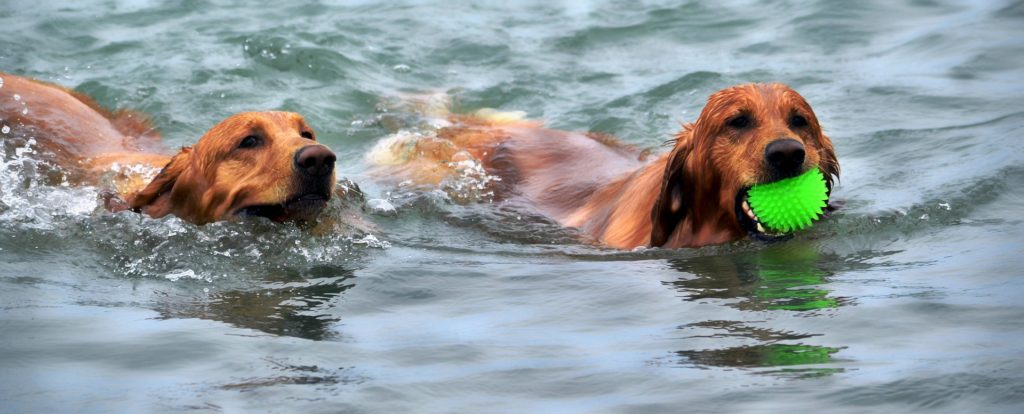
This entry was posted in Dogs
When we got our Miniature Schnauzer, we had already had a catflap in the back door for years. We soon realised that our little dog would easily also fit through the cat flap, and this would allow her to go in and out of the yard whenever she liked. We decided to pin it open to see if she would even use it at all, and it turned out to be a hit. It worked perfectly and in the summer it was nice to have a light steady breeze from the door. But we all know, summer must come to an end one day. And it did.
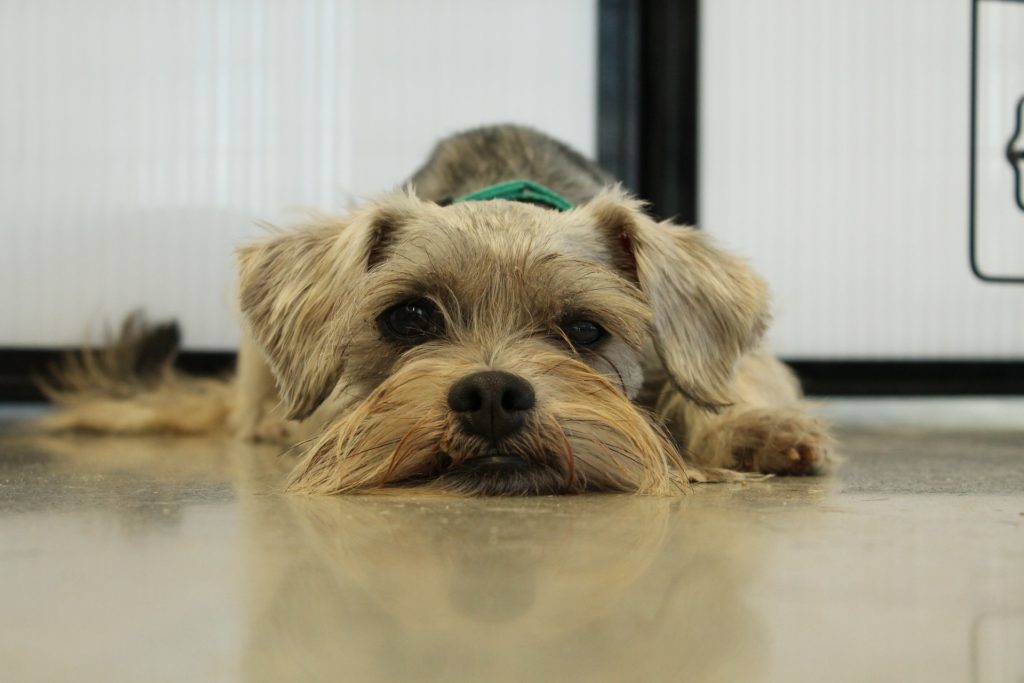
Winter came and with that freezing air blowing through the cat flap every day, all day. Unpinning the door meant having a sad little furry dog staring at it in disbelief “This used to be open all the time! Why is it locked now? And since when can the cat walk through walls?” The surprised look on our dogs face every time the cat appeared and vanished in the door was adorable and yet a little upsetting. How she wished to have the cats ability of passing through closed doors. And I wished that too. The comfort of going in and out whenever she wanted proved to make for a demanding dog, that needed help to open and close the door. Countless times a day.
Something had to change. As she didn’t understand how the door worked, we would have to show her and help her a little. I had used clicker training with other dogs before, and it was not only fun for me but also for the dog. Somehow we had never started training our newcomer with it, but now I dug out the clicker from the ominous corner drawer in the kitchen that hardly ever gets opened these days and made a plan.
Teaching my dog to use the cat flap!
My dog got the concept in a matter of hours and used the door by herself on the next day. Now she is young and very intelligent, but older dogs should also be able to learn this trick in no more than a few days.
Dog Clicker Training for flap doors – let’s get started.
Four essential things you need:
- A clicker
- Small dog treats or favorite toys
- A cat flap
- A dog (any dog will do…)
Clicker Training
If you’ve never heard about clicker training, then I will try to quickly introduce you to it. In short, clicker training conditions the dog through positive reinforcement to repeat certain behaviors. There is no such thing as active punishment in this training – “punishment” is shown in a passive manner by ignoring the dog. Dogs thrive on attention, they mostly don’t mind if it’s positive or negative attention – they often might not even be able to tell them apart. As long as their favorite humans interacts with them, that’s great news. Nothing is worse for a dog than being ignored. This is very useful when it comes to training.
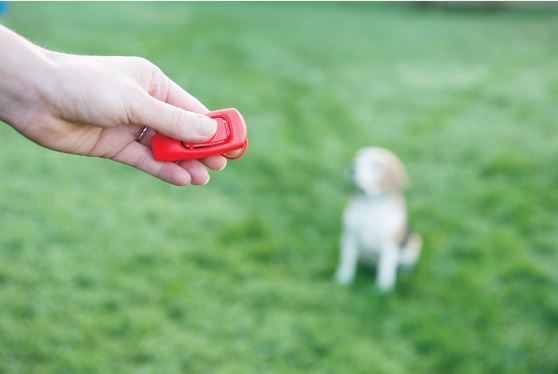
A click tells the dog “That’s exactly what I wanted you to do!”, then a treat follows. Click means treat – that is very important. Never click without it being followed by a treat – even if you click by accident. Click and treat go hand in hand. For most dogs, food treats work great, it is possible though to offer toys as a reward instead. Depending on the dog or the situation – I don’t take the clicker on walks for example, but I use the same method of “Do well and something good happens” to train my dog to, for example, stay sitting while I walk away. If she waits for my release command and comes running, we play with her toy. If she runs towards me without the command, we don’t play. That way she realizes that, even though staying put might not be the most fun thing to do right now, but when that’s done, there are better things to come!
Step one
But let’s go back to the cat flap. If your dog already works with clickers, then great, skip this paragraph and read the next. For everyone who has never used a clicker with their dog, you will want to get your dog accustomed to the clicker, what it does, how it works and how he/she can actually “make it click” to get to that tasty treat.
I admit, I am very impatient and extremely lucky with my dog. I have done all this in fast forward mode, but generally it is best to take some time and be patient… Start with teaching your dog what the noise means. With your dog in the same room, click the Clicker. Your dog will most likely look up at the noise, but even if he doesn’t, make sure to click and immediately offer him a tasty, small treat.
Click again, give the treat.
Click again, give the treat. Repeat.
Click again – does your dog already look a little excited about the noise? Good, he is starting to realise that a treat follows the click every time he hears it.
This stage shouldn’t take long at all, and it’s soon time for the next step.
Step two
I thought about what skills the dog would need to open the door. To go through the door she would have to push it with her nose. So my next goal was to get her to touch the cat flap with her nose. The direct approach didn’t seem to be very successful, so I got a colorful Post-It note out of the cupboard. Maybe this isn’t necessary if you manage to make your dog touch the door with its nose. However, I wiggled the bright pink piece of paper in front of her nose and the first thing she does is give it a quick sniff. As soon as her nose touches the paper – CLICK! and treat.
Move a few steps away and show the paper, have the dog follow you, trying to touch the paper with its nose.
When the dog touches the paper reliably, you can now introduce a command such as “Touch” every time the dog does the action. Your dog will soon connect the motion of touching the paper with the word.
Keep this up until she touches the paper with her nose every time she sees the paper. Once this works well, phase three can begin – stick the Post-It on the flap door.
Step three
With the Post-It on the flap and the dog knowing the “touch” command, the next step was quite easy.
Ask your dog to touch the paper. Click when they do. Your dog might not push the door yet, so start to encourage him to touch it harder. Stop clicking if the nose only just touches it, instead click only when the dog put enough pressure on the door and the door slightly wiggles.
Does the door wiggle a little every time now? Great, then take away the click again until your dog starts to push the door harder.
This is a gradual process and encourages the dog to think about what you want it to do. When he figures it out himself, he learns a lot faster. Teach him gradually to not just make the door wiggle but to push so hard, that he has to stick his head through – at this point he will usually have realized that he can walk through as the door actually reveals what’s behind, and eventually you will be able to gradually change the slight door touching to actually walking through. Like magic!
Done!
My dog was finally able to make her way in and out of the house whenever she wanted – and we could finally take off the second layer of socks.
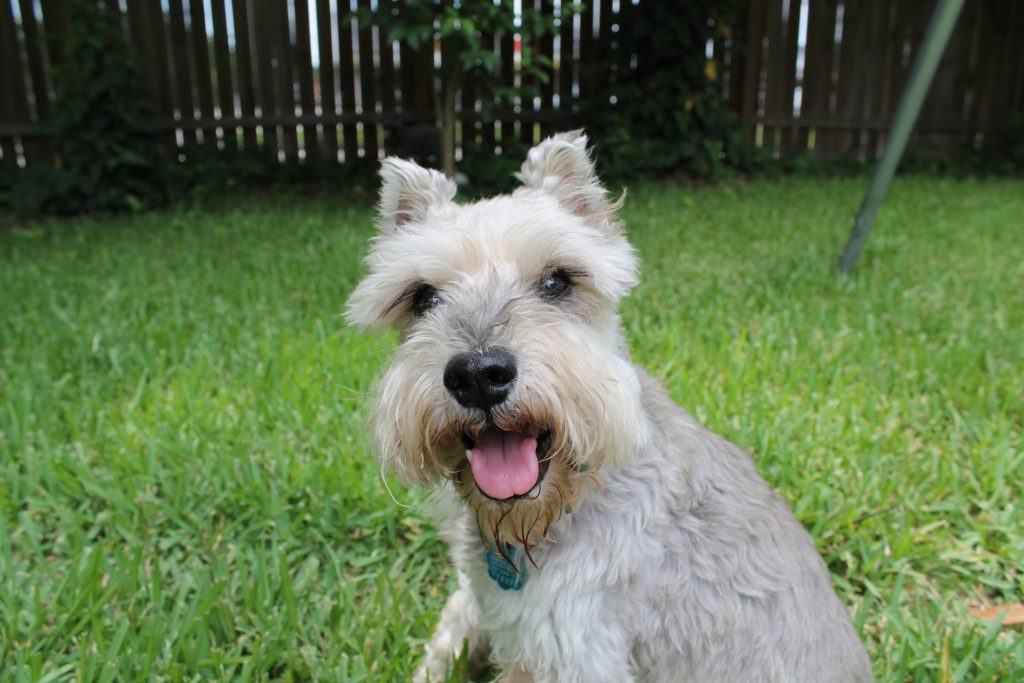
This entry was posted in Dogs
Did you just get a new puppy who is learning the rules of the house? Maybe your dog has behavioral problems, such as chewing on shoes or furniture. Or maybe you just want an easier way to travel with your dog. If you’re in any of these situations, crate training your dog might be the best option.
Crate training can be a controversial topic, but if we look at how dogs live in the wild, we realize it is a natural method to keep your dog comfortable and calm. Dogs are naturally den animals, which means that they feel comfortable in a small area they consider safe. A crate can simulate that for your dog.
A couple of other things to consider:
Never use a crate as a form of punishment.
Pay attention to your dog’s reaction to the crate- some dogs are more averse to crates, especially rescue dogs or any dog that spent a lot of time in a cage as a puppy.
Make sure you choose a crate that is properly sized for your dog. You can buy a larger crate that your dog can grow into, just block off a section of it until your dog grows.
Below you will find a guide to crate training your dog the proper way. As with any type of training, never force your dog to do anything they are visibly uncomfortable with. Treat this as another way to bond with your dog!
Courtesy of: TheBarkBuzz
This entry was posted in Dogs






 Play Fetch in The Living Room
Play Fetch in The Living Room A dog who has been taught positive behavior will be your best friend – fun, affectionate and reliable. It’s straightforward teaching your dog this canine version of positive thinking, but it won’t happen unless you lead the way.
A dog who has been taught positive behavior will be your best friend – fun, affectionate and reliable. It’s straightforward teaching your dog this canine version of positive thinking, but it won’t happen unless you lead the way. 2. Affection
2. Affection 4. A trip to a favorite place
4. A trip to a favorite place 1. Keep it simple
1. Keep it simple 3. Quality time
3. Quality time










